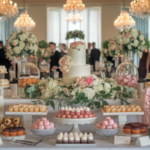I’m excited to share with you the art of creating French pastries, specifically Petit Fours, which are known for being elegant desserts. These delicate treats have been a staple in French patisserie since the 18th century, and I’m eager to guide you through the process of making them.
With their small size, delicate flavors, and beautiful decorations, Petit Fours are the perfect addition to any special occasion. Whether you’re a seasoned baker or a beginner, this guide will walk you through the process of making these French pastries, from preparing the ingredients to decorating the final product, resulting in exquisite elegant desserts.
Introduction to Petit Fours
In this article, we’ll delve into the world of French pastries, exploring the history and significance of Petit Fours, as well as providing a comprehensive guide on how to make these elegant desserts.
Key Takeaways
- Understanding the history and significance of Petit Fours in French patisserie
- Learning the basics of making French pastries, including ingredients and equipment
- Mastering the art of decorating Petit Fours with poured fondant and professional garnishing techniques
- Discovering tips and tricks for troubleshooting common decorating issues
- Creating elegant desserts perfect for special occasions
- Exploring the world of French pastries and their role in French cuisine
What Are Petit Fours: Understanding These Classic French Pastries
As I delve into the world of baking, I find myself fascinated by the concept of Petit Fours. These classic French pastries are a staple at special occasion treats, and for good reason. With their delicate flavors and exquisite presentation, they add a touch of elegance to any celebration.
When it comes to baking Petit Fours, there are several types to explore. These can be categorized into cakes, tartlets, and meringues, each with its own unique characteristics and flavors. For instance, cakes can range from vanilla to chocolate, while tartlets can be filled with fruits or nuts. Meringues, on the other hand, offer a light and airy texture that’s perfect for special occasions.
The Origins of Petit Fours
The history of Petit Fours dates back to 18th century France, where they were served as a sweet treat at social gatherings. Today, they remain a popular choice for weddings, birthdays, and holidays, thanks to their versatility and ease of serving.
Different Types of Petit Fours
Some popular types of Petit Fours include:
- Cakes: vanilla, chocolate, and red velvet
- Tartlets: fruit-filled, nut-filled, and chocolate-filled
- Meringues: individual meringue cookies or meringue-based desserts
These varieties offer a range of flavors and textures, making them perfect for special occasion treats.
Why Petit Fours Are Perfect for Special Occasions
Whether you’re hosting a wedding, birthday, or holiday party, Petit Fours are an excellent choice for special occasion treats. They can be easily customized to fit your theme and color scheme, and their bite-sized portions make them perfect for serving to a large group of guests.
Essential Ingredients and Equipment for Perfect Petit Fours
To make perfect Petit Fours, you will need a variety of ingredients, including flour, sugar, eggs, and butter. These ingredients are essential for baking the cake, which is the base of the Petit Fours. Cake decorating is also an important aspect of making Petit Fours, and it requires specialized equipment, such as a pastry bag and tips.
Here are some of the essential ingredients and equipment you will need:
- Flour
- Sugar
- Eggs
- Butter
- Pastry bag and tips
- Baking pans

In addition to the ingredients and equipment, baking skills are also necessary to make perfect Petit Fours. You will need to know how to mix the ingredients, bake the cake, and decorate it with fondant or other toppings. With the right ingredients, equipment, and skills, you will be able to create beautiful and delicious Petit Fours that are perfect for any occasion.
Remember, practice makes perfect, so don’t be discouraged if your first batch of Petit Fours doesn’t turn out as expected. Keep trying, and you will soon become a master of cake decorating and baking.
| Ingredient | Quantity |
|---|---|
| Flour | 2 cups |
| Sugar | 1 cup |
| Eggs | 4 |
| Butter | 1/2 cup |
Petit Fours Recipe:
Ingredients
- 2 cups all-purpose flour
- 1 cup sugar
- 4 eggs (room temperature)
- 1/2 cup butter (softened)
- 1 tsp vanilla extract
- Poured fondant or glaze for decoration
- Garnishes: sprinkles, edible flowers, or piped designs
Instructions
- Make the Base Cake:
Preheat your oven to 350°F (175°C). Cream butter and sugar, then add eggs one at a time. Mix in vanilla. Fold in flour gently. Pour batter into a greased 9×13 pan and bake for 25 minutes. Cool completely. - Cut and Shape:
Once cooled, cut the cake into small squares or circles using a sharp knife or cookie cutter. Aim for bite-sized pieces. - Decorate:
Warm poured fondant and dip each cake piece for a smooth coating. Garnish with sprinkles, piped designs, or edible flowers. - Serve:
Allow decorations to set, then plate your Petit Fours for an elegant presentation. Perfect for weddings, birthdays, or afternoon tea!
Enjoy these exquisite French pastries that bring elegance to any occasion!
Making the Perfect Petit Fours Base Cake
To create beautiful and delicious special occasion treats, such as Petit Fours, it’s essential to start with a perfect base cake. As a key component of elegant desserts, the base cake should be delicate, moist, and flavorful. In this section, I will provide tips and techniques for making the perfect Petit Fours base cake.
Preparing the cake batter is the first step in making the perfect base cake. It’s crucial to use high-quality ingredients, such as fresh eggs, real butter, and pure vanilla extract, to ensure the cake is rich and flavorful. The batter should be smooth and creamy, with no lumps or air pockets.
Preparing Your Cake Batter
- Use room temperature ingredients to ensure the batter mixes smoothly
- Don’t overmix the batter, as this can result in a dense cake
- Add flavorings, such as vanilla or almond extract, to give the cake a unique taste
Once the batter is prepared, it’s time to bake the cake. To achieve even layers, it’s essential to use the right baking technique and temperature. The cake should be baked at a moderate temperature, with a consistent heat distribution, to prevent it from burning or undercooking.

Baking Tips for Even Layers
By following these tips and techniques, you’ll be able to create a perfect Petit Fours base cake that’s sure to impress your guests. Whether you’re making special occasion treats or elegant desserts, a delicious base cake is the foundation of a beautiful and tasty final product.
| Ingredient | Quantity |
|---|---|
| Flour | 2 cups |
| Sugar | 1 cup |
| Eggs | 3 |
Decorating and Finishing Your Petit Fours
To create beautiful and elegant French pastries, such as Petit Fours, it’s essential to master the art of decorating and finishing. This process involves several techniques, including making the perfect poured fondant, using professional garnishing techniques, and troubleshooting common decorating issues.
When it comes to cake decorating, the right tools and equipment are crucial. Specialized equipment, such as pastry bags and tips, can help you create intricate designs and patterns on your Petit Fours. With practice and patience, you can achieve professional-looking results that will impress your guests.
- Making the perfect poured fondant, which involves heating and cooling the fondant to the right temperature
- Using professional garnishing techniques, such as piping borders and creating intricate designs
- Troubleshooting common decorating issues, such as uneven frosting or broken fondant
By mastering these techniques and using the right equipment, you can create stunning French pastries that are perfect for special occasions. Whether you’re a beginner or an experienced baker, with practice and patience, you can achieve professional-looking results that will impress your guests and satisfy your sweet tooth.
| Technique | Description |
|---|---|
| Making the perfect poured fondant | Heating and cooling the fondant to the right temperature |
| Using professional garnishing techniques | Piping borders and creating intricate designs |
| Troubleshooting common decorating issues | Fixing uneven frosting or broken fondant |
Conclusion: Mastering the Art of Petit Fours
As we conclude our exploration of these exquisite French pastries, I’m confident that you now have the tools and knowledge to master the art of baking bite-sized cakes. With the right baking techniques and attention to detail, creating beautiful and delicious Petit Fours is well within your reach.
Whether you’re hosting a special event or simply want to indulge in a touch of elegance, Petit Fours are the perfect solution. By applying the principles we’ve discussed, you can craft these miniature masterpieces that are sure to impress your guests and satisfy your sweet tooth.
Remember, the key to perfecting Petit Fours lies in your dedication and willingness to experiment. Don’t be afraid to try new decorating techniques, flavor combinations, or presentation styles. With each batch, you’ll gain valuable experience and develop your skills as a Petit Fours artisan.
So, let your creativity shine and embrace the joy of baking these bite-sized delights. Whether you’re a seasoned baker or a newcomer to the world of Petit Fours, I encourage you to dive in and explore the endless possibilities. Happy baking!






